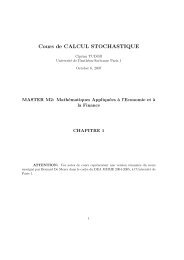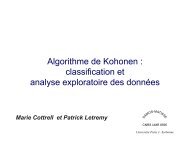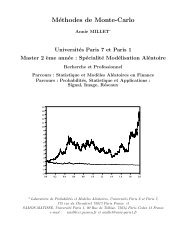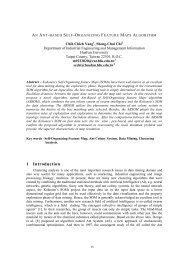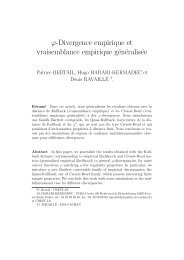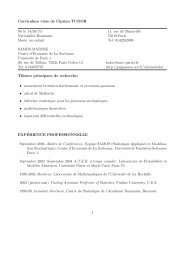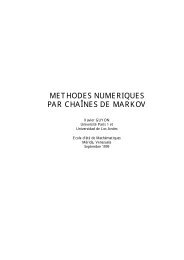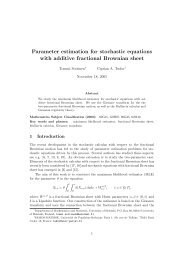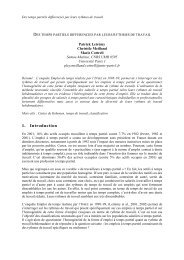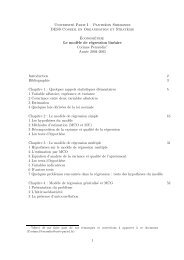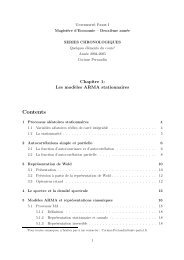Fast vector quantization with topology learning
Fast vector quantization with topology learning
Fast vector quantization with topology learning
Create successful ePaper yourself
Turn your PDF publications into a flip-book with our unique Google optimized e-Paper software.
WSOM 2005, Paris<br />
methods create topological structures that are more flexible than SOM and thus better capture<br />
the topological relationships in the input data distribution. Constructive approaches speed up<br />
<strong>learning</strong> by leveraging hierarchical structures and growing the structure on demand. While<br />
most constructive methods use specialized data structures for speeding up <strong>learning</strong>, SAM-SOM<br />
proposes a different approach. It takes advantage of off-the-shelve hierarchical indexing<br />
methods to scale to large datasets and number of dimensions. This innovative proposal<br />
eliminates the need to develop specialized data structures for speeding up the search for the<br />
best matching unit (BMU), a key operation in <strong>topology</strong> <strong>learning</strong> algorithms.<br />
Topology-<strong>learning</strong> algorithms usually attempt to learn the <strong>topology</strong> online. As a result, these<br />
algorithms require slow adaptation to the data. With few exceptions (e.g., GNG and SAM-<br />
SOM), online <strong>learning</strong> algorithms use multiple decaying parameters, which lead to relatively<br />
slow training. SAM-SOM is the only algorithm that attempts to learn a topological structure<br />
<strong>with</strong> a node for each input data <strong>vector</strong>. The algorithm use simple rules for creating and pruning<br />
connections. It is not clear, however, that these simple rules can approximate well the <strong>topology</strong><br />
of input data distributions <strong>with</strong> uneven density and different dimensionalities in different areas<br />
of the input space.<br />
Vector <strong>quantization</strong> is a lossy compression technique that uses a codebook for encoding and<br />
decoding data. Vector <strong>quantization</strong> techniques are aimed at creating small codebooks capable<br />
of encoding and decoding data <strong>with</strong> the smallest possible difference between original and<br />
reconstructed data. Vector <strong>quantization</strong> can also be seen as a special case of clustering. As in<br />
clustering, many data records are mapped to a single code<strong>vector</strong> or cluster. Some applications<br />
of <strong>vector</strong> <strong>quantization</strong> include speech and image compression.<br />
Vector quantizers for high dimensional <strong>vector</strong> spaces need a large codebook to achieve a small<br />
error rate. The Tree-Structured Vector Quantizer (TSVQ) [11] is a popular technique that<br />
scales well for large datasets and codebook sizes. Different versions of k-d trees have also been<br />
proposed for fast <strong>vector</strong> <strong>quantization</strong> [1]. k-d trees produce encoders <strong>with</strong> smaller memory<br />
footprint and faster encoding than TSVQ but, in general, they require larger codebooks for<br />
achieving the same level of compression of TSVQ.<br />
As the size of the tree (codebook) grows the ability of approaches such as TSVQ and k-d trees<br />
to return the actual nearest neighbor to a input <strong>vector</strong> decreases. That is, the closest code<strong>vector</strong><br />
(leaf centroid) to a given input may not be the one where the input is mapped to by the tree.<br />
The problem becomes more accentuated in axis-parallel approaches like k-d tree, where the<br />
partition imposed by the tree at each point is not well aligned <strong>with</strong> the data distribution<br />
principal directions. In general, tree-structured approaches trade speed for higher <strong>quantization</strong><br />
error for a fixed codebook size when compared <strong>with</strong> full search approaches such as the LBG<br />
algorithm [11]. Some approaches have tried to minimize the impact of the error in the tree<br />
assignments by searching multiple paths at the same time [2, 4, 5] or by exploring a learned<br />
topological structure to search near-nodes for a better match [1, 7, 14]. Arya and Mount [1]<br />
have shown that the latter requires significantly less computation than the standard k-d tree<br />
approach for achieving the same level of error. Unfortunately, for a dataset <strong>with</strong> N input<br />
<strong>vector</strong>s, the RNG* algorithm used in [1] scales <strong>with</strong> O(N 2 ), making it unsuitable for large<br />
datasets.<br />
This paper proposes a new algorithm called a <strong>vector</strong> approximation graph (VA-graph) that<br />
leverages a tree based <strong>vector</strong> quantizer to quickly learn the topological structure of the data. It<br />
then uses the learned <strong>topology</strong> to enhance the performance of the <strong>vector</strong> quantizer. VA-graph<br />
can also learn graphs <strong>with</strong> as many nodes as the number of input <strong>vector</strong>s. Due to space<br />
constraints, the algorithm is presented in a batch version only. The paper is divided in 5<br />
sections. Section 2 presents the tree construction step in VA-graph. Section 3 describes the



